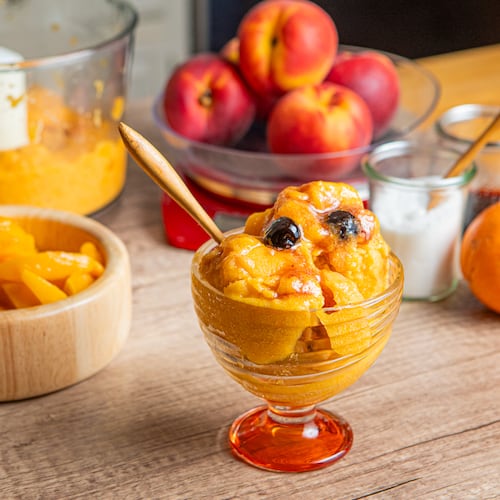Cheese pro tips
From Whole Foods global cheese buyer Cathy Strange:
• When you spring for a nice cheese, plan to consume it within two to three days. Cheese is always changing. A good cheese monger sells it to you at its prime.
• When you get your cheese home, gently wrap it in wax paper (or special cheese paper), then seal it into a baggie. This gives it a little air, but protects it.
• Stash it in the crisper. Cheese takes in other flavors that may be free-ranging in your fridge.
• Try a cheese with an orange rind. These are the “washed rind” cheeses, which were rinsed with a brine (or, sometimes, beer), then collected free-floating bacteria that turn them orange.
• Re-think grilled cheese. Cathy suggests it sans bread. Throw a slab of Gruyère on the grill until it softens and takes on some charcoal flavor, then serve.
Cathy Strange carries knives. They may not protect her in a dark alley, but she has to check them when she flies — which she does, a lot. Strange’s knives probe and slice and core and break cheese all over the world.
Strange spends much of her life in pursuit of cheese as an internationally respected cheese judge and the global cheese buyer for Whole Foods Market. She travels about half the time, talking about cheese, working with cheese-makers and identifying stock for Whole Foods cheese cases. She judges, on average, three cheese competitions a year. At the World Championship in March in Madison, Wisconsin., she judged three categories: rindless blue, matured Gouda and flavored aged goat.
For the rindless blue judging, she was paired with a judge from Spain. Together, they faced a roster of 42 cheeses. They had four hours.
When Strange tastes a cheese, she starts with her eyes. Does it have any unusual colors? How does the texture look — creamy? Chalky? Next comes the nose. “85 percent of your taste is actually through your smell,” she says. Any off aromatics? She considers what she perceives via sight and smell, then she puts it in her mouth.
When we tasted an aged goat cheese called Bonne Bouche at the cheese counter in the Whole Foods in downtown Austin, I thought, “Mmmm.” Strange said, “The texture is really nice and dense, coats your palate.” As my brain moved on to, “I like this,” Strange continued: “You get some of that citrusy acid, kind of like soft lemon. It’s really, really soft on the front. Then you’re tasting the rind on the back. It’s a little bit woodsy, just along the exterior of your palate. And then, as it goes back up into your nose, that’s where you’re going to get a lot more flavor nuances — we kind of get some nutty, woodsy, fungal, kind of mushroom. Soft mushroom flavors.”
And she was right. Of course she was right. She’s one of the premier cheese experts in the country. Even the French have agreed that this New York-born, North Carolina-raised Austinite knows her cheese. They awarded her with membership in the Guilde Internationale de Fromagers and made her president of its New World branch. She’s a former president of the American Cheese Society, too, and has a whole list of other impressive affiliations. With all these qualifications, Strange is in high demand as a judge at cheese competitions around the world. Which brings us back to the blue tasting in Wisconsin.
Zooming around the world tasting cheese sounds like a dream, but these contests can be grueling. Objectively judging 42 cheeses in a four-hour span requires mental focus and physical endurance. Strange puts every cheese she tastes in her mouth to get a feel for the cream on the tongue, then chews it to a liquid to release the flavors and “taste every little nuance.” Then she spits it out and rinses with an acidic fruit juice, such as pineapple or apple, to cleanse her palate. “I have to be very careful not to have palate fatigue,” she says. Every cheese, or rather its maker, deserves a fair shot. So she drinks lots of water. If she gets tired? “I walk away.” She returns when she feels refreshed. If she has a cold? Forget it. She cancels. Mucous interferes with cheese tasting.
If judging cheese is a complicated process, making it is, too. Or is it simple? Cheese has four essential ingredients: milk; rennet or an enzyme to serve as a coagulant; a culture, whether airborne or inoculated; and salt. To make it, Strange points out, first you must acquire milk – a more complicated step than most people would expect.
Milking animals generally live for two years before they can produce milk, so an aspirant farmstead cheese-maker (one who makes cheese on the farm where the milk was produced) must purchase a calf or a kid or a lamb and nurture it for two years before getting a drop. On the upside, farmstead milk doesn’t have to travel. Time and jostling contribute to the breakdown of the proteins in milk that, in turn, can impart flaws to cheese.
Milk in hand, a cheese-maker heats it, then adds a coagulant, plus a culture — bacteria carefully selected according to the type of cheese desired. The milk separates into solid curds and liquid whey, some 80-85 percent of the milk’s volume. The delicate curds, then, must be handled with care. They’re marvelous, but sensitive, nuggets of springy protein.
Next, the cheese-maker adds salt and loads the curds into a mold — a wheel for a cheese you buy in a wedge, like Parmesan or Brie, or a block for cheeses sold in rectangles, like cheddar or Havarti. In the mold, a cheese takes on a shape and begins to develop a rind. Next comes maturation — the phase where a cheese ages under controlled conditions, developing its full character. This process can take a day, in the case of a fresh goat cheese, or multiple years, in the case of an aged Gruyère. A cheese is never fully done, though, until you eat it.
“Cheese is alive,” says Strange, and she’s not speaking figuratively. The cultures in cheese continue to multiply, metabolizing sugars and exhaling gasses for as long as they exist, their flavors and aromas developing all the while. When she judges a cheese, she recognizes that her observations apply to a product in a state of constant change. “I’m judging that wheel, that day, at that time,” she says.
Strange grew into the role she plays today. In her mid-20s, she was teaching and coaching collegiate tennis in Tennessee when her mother fell ill, and she went back to North Carolina to be closer to her. While she was there, a friend asked her to help out at a northern Italian restaurant in Durham. So began a love of food that would take Cathy, in the early 1980s, to the wine department of a small grocery store. Years later, that store would be purchased by Whole Foods Market and become its 11th store. (Store number 373 opened this year.)
Strange learned about wine on the job and eventually transitioned to cheese, which is not so different, really. “Cheese is like wine in the sense that they’re both agricultural products,” she says. Cheeses and wines both taste of place, what the tasters call terroir. Soil composition affects the grass that grows from it. Grass qualities influence the flavor of milk produced by animals that graze on it. Milk, with its varying balances of protein and fat, yields curds of differing characteristics. Innumerable variables yield a dizzying diversity of cheeses. Cheese comes in all different colors and shapes, textures and scents.
Strange has a knife for every one. When she unfurls her roll-up canvas carrier, a dozen different implements peek out from secure pockets, while nearly as many remain hidden in customized carriers.
A set of four graduated stainless-steel cheddar irons nestle inside one leather case. Each one of these looks like a chisel with a curved shaft and a heavy cylindrical handle. Strange uses the handle like a hammer to tap the outside of a wheel of hard cheese, listening for cracks like studs in a wall. The chiseled end serves as a corer, twisted in and pulled out of a wheel to retrieve a sample that can be evaluated for aroma, consistency and elasticity — all indicators of quality and maturity.
While many of her tools are exotic, Italian- or Japanese-made specialists, the graters look familiar. “They let me smell the aromatics better,” Strange says.
Cheese, too, runs the gamut from familiar to exotic, broadly available to hard-to-get. From a slab of melting orange on top of a burger to an exotic, gooey lump that smells like dirty socks, it’s all cheese. Strange loves talking about it all.
Strange keeps a busy schedule, but she takes time to wander, too. “When I’m in Wisconsin,” she says, “I’ll be there for three days where I’ll just be out and tasting cheeses.” She knows most of the cheese makers, certainly in the U.S., but in Europe, too. Still, there’s always something new to learn, or someone new to meet. “I stop randomly,” she says. “If there’s some interesting food place, then I can say to them, ‘Is there anything interesting going on with cheese?’ or, ‘Who’s the best cheese maker here?’”
“Cheese has gotten better and better and better because now we have people dedicated to learning and making cheese,” says Strange. Factor in advances in microbiology and controlling humidity and temperature — mechanical refrigeration came to American households only in the early 1900s – and you have a whole new world of cheese.
What’s more, today we have a whole new world of cheese eaters. “The millennials are very active with food exploration,” Strange says. “They know a lot of flavors, and so they’re very educated around food. They have a lot of things that we didn’t have when I was younger. And the older generation is losing their taste buds, so they’re liking more flavorful cheeses.” In short, it’s a great time to eat cheese.
About the Author
The Latest
Featured

